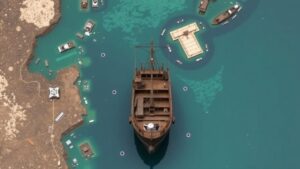Mapping Historic Maritime Trade Routes Using NOAA and Library of Congress Data
Mapping Historic Maritime Trade Routes Using NOAA and Library of Congress Data
The maritime trade routes have played a critical role in shaping economies, cultures, and geopolitical landscapes throughout history. This article delves into the methodologies and significance of utilizing data from the National Oceanic and Atmospheric Administration (NOAA) and the Library of Congress to map these historic routes comprehensively. By engaging with these datasets, researchers can uncover patterns and implications that define our maritime heritage.
The Importance of Maritime Trade Routes
Maritime trade routes have been the arteries of economic and cultural exchange since ancient civilizations. movement of goods, people, and ideas across oceans has significantly contributed to the development of societies. For example, the Silk Roads maritime extension, the Maritime Silk Road, facilitated trade between the East and West, allowing for the exchange of silk, spices, and cultural practices.
In quantifying this historical context, studies have shown that the global maritime trade landscape was valued at approximately $14 trillion in 2021, underscoring its continued relevance in global economics (UNCTAD, 2021). Understanding historic routes aids in appreciating current economic patterns, environmental impacts, and cultural interactions.
NOAA Data and Its Applications
NOAA provides extensive datasets relevant to oceanic and atmospheric conditions, shipping routes, and navigational hazards. e data are crucial for mapping historic maritime routes accurately.
- Historical Maps: NOAA’s Office of Coast Survey supplies historical nautical charts, dating back to the 18th century, which depict navigational routes used by ships.
- Weather Patterns: NOAA’s climate data helps researchers understand the weather conditions affecting maritime travel, which can determine routes based on prevailing wind and tide patterns.
- Environmental Impact Assessments: NOAAs ecological data allows for a study of how historic shipping routes have influenced marine environments over time.
For example, NOAA’s historical nautical charts highlight ship routes from major trade hubs like Port of New York and San Francisco, illustrating changes in maritime navigation due to technological advancements and environmental factors.
Utilizing Data from the Library of Congress
The Library of Congress serves as a repository of historical documents, maps, and texts that provide context and detail about maritime trade. Key resources include:
- Historical Documents: Collections of letters, diaries, and shipping logs inform researchers about the daily operations and routes of trade vessels.
- Cartographic Archives: The Geography and Map Division houses an extensive collection of maritime maps and atlases, including early navigational charts.
- Legislative Records: Congressional records can reveal governmental actions affecting maritime trade laws and regulations over time.
For example, an 1855 shipping log detailing the exports from New Orleans provides insight into the goods exported and the routes taken, revealing the interdependencies of port cities along the Gulf of Mexico.
Methodologies for Mapping Maritime Routes
Data Integration and Analysis
To map historic maritime trade routes effectively, researchers often rely on Geographic Information Systems (GIS) to integrate data from NOAA and the Library of Congress. This method allows for spatial analysis and visualization of historical patterns.
For example, by layering NOAAs nautical charts with historic shipping logs from the Library of Congress, scholars can visualize shifts in trade routes over time, such as the transition from sailing ships to steam-powered vessels in the 19th century, which revolutionized coastal trade.
Case Study: The Atlantic Slave Trade
A poignant example of utilizing NOAA and Library of Congress data involves mapping the Atlantic Slave Trade. By analyzing shipping routes recorded between the 16th and 19th centuries alongside data on sea conditions, researchers illustrate the specific paths taken by slave ships. Findings from this integration indicate that specific routes were optimized based on prevailing winds and currents.
According to the Trans-Atlantic Slave Trade Database, over 12 million Africans were forcibly transported to the Americas, with distinct routes evident in the legacy of maritime practices shaped by peak years in the trade, such as 1701-1800 when the Atlantic route was heavily trafficked.
Conclusion
Mapping historic maritime trade routes using NOAA and the Library of Congress data presents a robust framework for understanding the intricate dynamics of trade, navigation, and environmental interactions over centuries. By leveraging these diverse data sets, researchers can uncover significant insights into the historical and contemporary impacts of maritime commerce.
Actionable takeaways for future research include:
- Expanding data integration techniques to include modern maritime data for longitudinal studies.
- Utilizing advanced GIS technology to analyze and visualize complex maritime patterns.
- Encouraging interdisciplinary collaboration between historians, marine scientists, and geographers to enhance research depth.
To wrap up, the methodologies employed in this analysis not only enrich our understanding of the past but can also inform contemporary maritime practices, contributing to sustainable and responsible shipping strategies in an increasingly globalized world.



